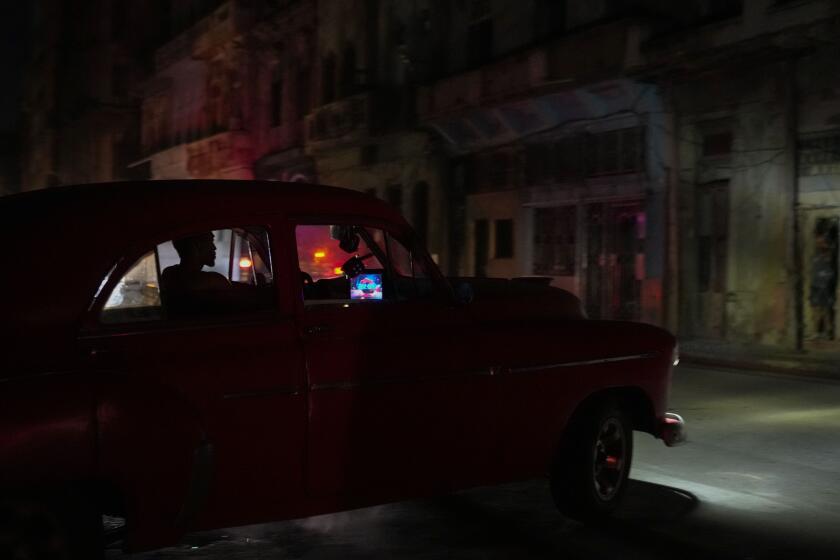French Quarter Icon Loses Je Ne Sais Quoi
If you didn’t know any better, you might think the trouble began when a beloved, bespectacled waiter named Gilberto got fired. But in truth, the storm over this antique French eatery had been gathering for years.
Maybe the fracas was inevitable. How could Galatoire’s, a last bastion of French Quarter gentility, expect to slip gracefully into another century? When machine cubes took the place of hand-chipped ice, the clientele griped. When the dress code weakened, they groused. When the restaurant accepted credit cards, they groaned. The changes were subtle--just the passing of time, really. Nevertheless, they blew an unnerving whiff of extinction into the air, and like some great endangered pack, the elite of New Orleans girded for a proper French Quarter revolution.
“I wouldn’t dream of going to Galatoire’s without a coat and tie,” said Kenneth Holditch, a retired American literature professor who’s writing a book about the 97-year-old restaurant. “And then to have to sit next to people wearing culottes!”
The rumblings of discontent exploded into a melee of manners after iconic waiter Gilberto Eyzaguirre was fired. The highly educated Peruvian immigrant started waiting tables at Galatoire’s a week after he arrived in the United States in 1979. To his customers, Eyzaguirre had been the incarnation of Galatoire’s. He remembered their drinks, whisked their appetizers to the table before they’d ordered, gave them lifts to appointments on his days off.
“I was part of the life there,” said Eyzaguirre, 56. “It wasn’t just business, and it wasn’t just friendship. It was even more profound.”
Eyzaguirre said he was fired for sexual harassment this spring after two women on the wait staff accused him of touching their arms and backs inappropriately. The restaurant won’t discuss the dismissal.
As news of the decidedly modern scandal rippled through the silks and tweeds of Galatoire’s, turmoil broke loose. Some of the eatery’s oldest patrons cried for a boycott pending the return of their favorite waiter. More than 100 letters of protest poured in. The complaints came from Sweden and Montana and Tucson, but mostly they came from New Orleans, penned in calligraphy on monogrammed stationery, signed by doctors and professors and military men.
A Web site, WeloveGilberto.com, shows off photographs of a grinning Eyzaguirre, letters from the disgruntled diners and an “action plan” that--genteel to its core--stops short of proposing any actual labor of either the physical or mental variety.
Le Chat Noir cabaret has a lengthy waiting list for the “Galatoire Monologues,” a piece of impromptu performance art in which the protest letters are read aloud--by the rabble-rousers themselves, sometimes--while an interpretive dancer arches and stomps.
“We are so vain in New Orleans--just give us a mirror and we’re happy,” said stage manager Su Gonczy. “They all feel royal, descended from kings, and anything that talks about them is fabulous. But there’s this drumbeat of losing their old world, this comfortable, elegant, very slow world. And that’s where the grief comes from.”
To understand why any of this matters, one must first relinquish the notion of Galatoire’s, the restaurant. Eating the lauded Creole cuisine is a side amusement here; Galatoire’s is really a sanctuary for old-fashioned, unapologetic elitists, who counted on the brilliant roomscape of light and crystal to stand firm against New Orleans’ riotous, restless jubilee. “It was a time warp,” said a wistful Holditch.
“It’s an icon,” maitre d’ Arnold Chabaud said. “It doesn’t happen anyplace else, and there’s no explanation for it.”
The traditions are rigid and plentiful: You waited in line to get into Galatoire’s. Or, more probably, you paid somebody else to stand in the queue. Once inside, you requested your waiter--the one who has been dishing your shrimp remoulade, crabmeat sardou and banana bread pudding for decades. You tipped more than generously, because you understood that Galatoire’s was staffed by career waiters and operated in a system of old-fashioned patronage.
You paid cash or ran a house account. You whispered about the other diners, which was easy, because the mirrored walls of Galatoire’s let you cast an eye over every face in the room without so much as turning your head. You came for lunch, but you stayed through dinner.
“My contention,” Chabaud said, “is Galatoire’s began when people were dirt poor, and it was the one place they could go and be treated like they were somebody. If a lady had just one nice dress in the closet, she’d wait all week to put it on and come out to Galatoire’s.”
The Galatoire family still runs the bistro, and much of New Orleans’ upper crust still jockeys to lunch in the lively first-floor dining room. But the apparition of blue jeans at the next table, the disappearance of embroidered napkins--these things are ominous augurs, all, to the hard-core traditionalists. The changes mean one thing: Old-timers are losing ground in the long and painful battle to preserve the soul of the French Quarter, a strip of stone, soft wood and sweaty humanity that is arguably the nation’s most defiantly anachronistic swath of real estate.
“It’s part and parcel of what’s happening to the French Quarter,” said Holditch, who stopped dining at Galatoire’s after Eyzaguirre’s dismissal. “It’s losing its old traditions. A lot of things have suddenly disappeared.”
In recent years, the Old Town Praline Shop on Royal Street--the one with the fresh pralines, the one that shunned air conditioning in favor of a vast ceiling fan--shut down. The family that ran the Chinese laundry sold it off. The Bourbon Street curio shop where the mythical Blanche DuBois bought her paper lantern is long gone. The department stores on Canal went under. New hotels cropped up. Francis Ford Coppola bought a house, and so did Nicolas Cage.
Modernity comes right up to Galatoire’s threshold. It’s in the mango daiquiris peddled for $7 on the corner. It’s in the polyester lingerie and Candy Pants laid like pirate’s booty in the window case of Bourbon Strip Tease next door. It’s in the twinkling riot of beer signs--Miller Lite! Coors! Budweiser!--in the window of the oyster bar across the street. It’s shuffling past in flip-flops and tank tops, circling too close for comfort.
In a letter posted on Gilberto’s Web site, Jules Jordy Jr. dubbed the evolution of Galatoire’s “an inexorable slide of Western culture toward a so-called classless, lowest-common-denominator type society.”
“Just imagine some sweaty tourist in a baseball cap and sneakers, from Dallas or Kansas City, with toothpick twirling between his lips, demanding A-1 sauce for the trout amandine and ketchup to put on the souffle potatoes,” Jordy wrote.
From the streets outside, the dull pump and moan of a blues bass seep through the dining room walls. Sometimes the sound comes through so loud that an interloper might mistake it for muted dinner music--but that would be a mistake, indeed. There is not now, nor has there ever been, dinner music at Galatoire’s.
“Galatoire’s,” said manager Melvin Rodrigue, “has its own music.”
And so it does. Voices clatter off the flat ceiling like marbles scattered on a floor. A pleasant porcelain cacophony pours forth from the kitchen. If you aren’t expecting it to look the way it did 10 years ago, it’s a vista so convincingly ornate the exit signs stand out as peculiarly contemporary. This is a screen on which the tragicomedies of New Orleans have been played out for decades, for generations. Tennessee Williams, they say, had a table here.
The brooding mahogany pillars and brass light fixtures still gleam. The somber black-and-white mugs of the founding family still glower down from the walls. You can’t see Bourbon Street from the dining room. The windows are delicately frosted, filmed with just-barely-opaque curtains--which, incidentally, Holditch referred to as “those godawful drapes. Pretty tacky, I think.” The old ones, he explained, were better.
At the front door, Chabaud is standing hawkish guard. When the men push inside clad in shorts, he pulls them aside--sometimes back onto Bourbon Street--and mutters in their ear. They flush and slip back into the passing throngs. Long pants are still required, and jackets for dinner.
This, after all, is Galatoire’s.
More to Read
Sign up for Essential California
The most important California stories and recommendations in your inbox every morning.
You may occasionally receive promotional content from the Los Angeles Times.









